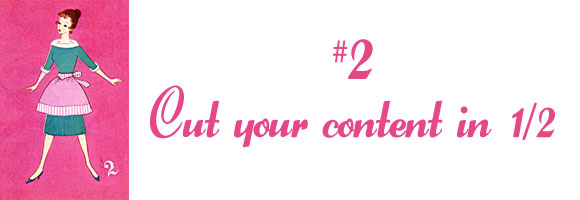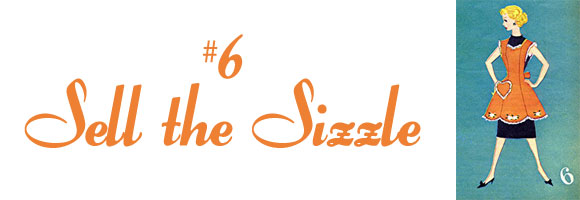by Lucy Thornton of Perfect Balance Marketing
.
This month’s theme on Oh My! Handmade is Spring Cleaning, so get out your yellow marigolds, dust off your apron, and prepare to add some serious sparkle to your marketing (in the spirit of new beginnings, I’m offering some free consultancy so if you’ve got any questions, keep reading to the end to find out how you can get answers to your burning marketing questions).
.
Once a company has its website up and running, it’s tempting to move resources (time, people and money) to other aspects of the business – making more products, finding more outlets, sourcing cheaper supplies.
.
But keeping your website spick and span all year round will bring you marketing results faster than a bottle of Mr Muscle, so here are seven ways you can blow away the cobwebs (excuse the pun) and get the traffic and results you deserve.
.
.
1. Hold the front page
.
Time and again I land on a website whose homepage is filled with dry copy about the company, where it’s based, what it sells, how long it’s been up and running. Yawn. Of course, you need to include that information somewhere, but it’s not exciting enough to hold anyone’s attention for longer than a few seconds so don‘t slap it on the homepage.
.
You have just a couple of seconds to engage with a visitor when they land on your site, so make your welcome work hard for you – tell them about your latest products and seasonal offers and direct them clearly where to find out more.
.
.
2. Cut your content in half
.
Reading on screen is very different to reading a book or a magazine.
Your website isn’t an online brochure. It’s a common mistake to make, but resist the urge to just copy and paste all the words from your leaflets and brochures and paste them onto your website.
When we read online, we want bite-size chunks of copy that we can skim – we want to know the key pieces of information such as price, size, origin, materials and the benefits that your product can bring.
Keep it concise, keep it to the point, and keep it laden with benefits.
3. You need to hear this!
.
“Working with [your name] was easy – she was patient, thorough and helped us make the right decisions for our business. We’ve seen our web traffic more than double in just a month and are already looking to [your name] for more exciting content.” Business owner, Company
.
What do your customers think about your products or service? Do you share that feedback with potential customers? You can’t put a price on a genuine gushing endorsement from a client who fits the profile of your target market.
Make a habit of requesting feedback from your customers, whether you sell jewellery, expertise or biscuits and, provided they give their permission, share those reviews online. You know you’re great, but when someone else says it, somehow it means more.
.
.
4. Sign here
.
In the good old days when there were only about four websites to visit on the web, just having a sign-up box on the homepage was enough for visitors to eagerly hand over their personal details, including favourite colour, inside leg measurement and preferred sleeping position.
.
But now we’re a bit more concerned about what sites will do with our data and it takes more than an empty white box and a flashing cursor to convince us to sign up. That shouldn’t stop you from having a subscribe form – it just means you need to make it worthwhile for people to give you their details.
.
Here are some tips on how you can build a database of eager customers:
- Ask for minimal information (name, email address and company should be enough)
- Make sure the form works – check it, then check again (and just to be sure, run another check)
- Thank subscribers for signing up – give away a free ebook, white paper or report that they’ll find interesting (make sure you know your customer and what they‘d like to read)
- Keep communications timely and relevant – an email selling your latest design every day is going to get annoying, so think before you click send.
..
.
5. Take the right path
.
Cath Kidston’s UK site is a maze of links – once you’re there, it’s very difficult to leave. The accessories page has links to all the individual products, as well as new collections. The product pages have ‘You might also like….’ suggestions to keep you hopping from product to product (much like the related posts at the bottom of this article).
There is also the option to ‘add to gift list’ or ‘email to a friend‘ for every product. So if you like something, even if you can’t afford it there and then, you can ask someone to buy it for you! How I love those little buttons…..
.
What links and pages do you want your web visitors to click? If they’re new to your site, they’ll probably begin at the homepage, before taking a peak at your ’About’ copy. If they like what they see, they may search out some examples of your work, check out a few testimonials to see if you’re really as good as you say you are, and finally find the product they want (and the ’Add to cart’ button).
.
Write down the path that your visitors may take, and provide pointers to help them. At the end of your ‘About’ page, add a link to your portfolio. On your portfolio page, add some testimonials and a link to a whole page of them. And include plenty of links back to your products and the ‘Buy’ button.
.
6. Sell the sizzle, not the sausage
.
When buying liquid soap, a consumer isn’t really looking for a bottle of blue smelly liquid. They’re looking for a life free from illness. They’re looking for that fresh feeling of just-washed hands.
.
When a customer buys a mobile phone, they’re not looking for a small plastic thing with a screen – they’re looking for a way to talk to their friends, spread good news, share pictures. They’re looking for the security of having a way to contact someone when they need help. The fact that the phone has 4.1 inch screen only matters because of the benefits it brings to photos and ease of use. We don’t really care that it has a 16GB memory – we care that it can hold all of our data, is quick and easy to use, and won’t let us down in an emergency.
.
Write down the features of your product:
Size
Colour
Materials
The production process
.
And then for each, write down what that feature brings to the customers – comfort, choice, security, great quality, the ‘wow’ factor. Focus on your benefits when writing your product descriptions, and back them up with features.
.
7. Break up your copy
.
When adding content online, the bullet point is your best friend.
Along with the numbered list, and the subtitle.
And the paragraph break. Use them wisely, but use them. Often.
And keep sentences short.
.
So………..
You up for the Spring cleaning challenge? Ready to pull back the drapes on your website and let the Spring warmth in?
.
Go revitalise and re-energise – and as I mentioned, I’m so enthused by the new season and the pretty flowers that are dancing in the English hedgerows, that I’m offering some one-to-one coaching to anyone who emails me (lucy@perfectbalancemarketing.com) by the end of April.
.
Just email me your marketing query and I’ll reply direct to you – then I’ll write a post on the most popular subjects. Because if you’ve got a question on it, there will be loads of other people with the same question.
.
Happy Spring!








